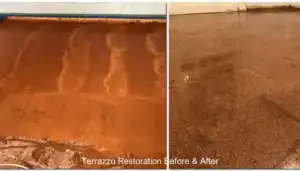


13 July 2025 by
sitemanager
Travertine is a beautiful natural stone that adds elegance and charm to any home. To truly appreciate its aesthetic appeal, professional travertine floor polishing is essential. This process not only enhances the appearance of your flooring but also provides numerous other benefits that can significantly impact your home’s environment and maintenance routine.

A polished travertine floor transforms an ordinary space into an extraordinary one. The natural beauty of travertine shines when it is polished to perfection. Polishing highlights the stone’s unique colours and patterns, making it a focal point in your home. This enhanced aesthetic appeal can elevate your interior design, making your living spaces feel warmer and more inviting.
In the UK, where traditional decor often meets contemporary design, polished travertine can blend seamlessly with various styles, from rustic country homes to sleek modern flats. Imagine hosting guests in a dining area where the travertine floors gleam under ambient lighting, creating a warm and welcoming atmosphere. You’re not just showcasing beautiful flooring; you’re enhancing the entire visual appeal of your home.
Furthermore, polished travertine can increase the perceived value of your property. Potential buyers often look for homes that require minimal work, and having well-maintained, polished floors can make a lasting impression. The right finish can reflect light beautifully, making spaces appear larger and more open. Thus, investing in professional travertine floor polishing not only enhances aesthetics but also serves as a savvy real estate move.
One of the most significant benefits of professional travertine floor polishing is the increased durability it offers. The polishing process enhances the surface of the travertine, making it more resistant to scratches, stains, and wear over time. This is particularly important for high-traffic areas in your home, such as hallways and kitchens, where floors often experience heavy foot traffic.
A polished surface helps protect against the elements, including moisture that can seep into unpolished travertine and cause damage. By applying a sealant during the polishing process, you create an additional barrier that prevents water and dirt from penetrating the stone. This not only prolongs the life of the flooring but also reduces the frequency of repairs and replacements, leading to significant cost savings over time.
Moreover, polished travertine floors can withstand everyday challenges better than their unpolished counterparts. Spills, dirt, and grime can be easily wiped away, reducing the need for harsh cleaning chemicals that can further damage the stone. When considering long-term maintenance, the durability provided by professional polishing becomes an invaluable aspect of home care.
Cleanliness is another critical advantage of professional travertine floor polishing. A polished finish makes it much easier to clean and maintain your travertine floors. The smooth surface prevents dirt and grime from settling into the pores of the stone, unlike unpolished travertine. This significantly reduces the time and effort needed to keep your floors looking pristine.
Regular maintenance becomes a breeze. A simple sweep or vacuum followed by mopping with a pH-neutral cleaner will suffice to keep your polished travertine in top condition. The shine that comes from polishing not only enhances appearance but also makes it clear when the floors need cleaning, as the glossy surface reflects light beautifully.
In homes with pets or children, the ease of cleaning becomes even more critical. Polished surfaces resist staining and mark-making better than unpolished stone, allowing families to enjoy their living spaces without the constant worry of damage or unsightly marks. An investment in professional travertine floor polishing translates to a cleaner and healthier home environment, ensuring you can focus on what truly matters—spending time with loved ones.

Finding exemplary professional travertine floor polishing services in the UK is crucial to ensuring high-quality results. With numerous options available, understanding how to navigate this process can lead to successful outcomes that meet your expectations and budget.
The first step in selecting a polishing service is to research local specialists who specialise in travertine care. Searching online for companies that focus on natural stone maintenance can yield a list of potential candidates. Look for businesses that have established themselves within your community, as local expertise often means familiarity with the specific challenges posed by regional climates and conditions.
When vetting potential services, consider their specialisation in travertine polishing. Not all floor care companies have the same level of expertise with natural stone, and selecting a specialist can make a significant difference in the final results. Visit their websites and social media profiles to assess their portfolio, showcasing before-and-after photos that demonstrate their ability to rejuvenate travertine.
Don’t hesitate to ask for recommendations from friends or family who may have previously used professional polishing services. Personal referrals can carry more weight than online reviews, providing you with peace of mind when making your decision.
Customer feedback plays a vital role in selecting an exemplary professional travertine floor polishing service. Reading reviews and testimonials allows you to gain insights into the experiences of others who have utilised the services of various companies. Look for reviews on popular platforms, such as Google and Trustpilot, as well as local community forums, to gain a well-rounded view of each provider’s reputation.
Pay attention to comments regarding reliability, professionalism, and the quality of work performed. Positive testimonials can give you confidence in choosing a service, while negative feedback can help steer you away from potential pitfalls. Look for common themes in customer feedback; consistent experiences—whether good or bad—can reveal a lot about a company’s strengths and weaknesses.
Furthermore, consider reaching out to previous clients for more in-depth insights. Many reputable companies are willing to provide references upon request, allowing you to ask specific questions about their quality of service and customer satisfaction.

Once you have narrowed down your choices for professional travertine floor polishing, it’s time to compare prices and services. Obtaining quotes from multiple providers gives you a better understanding of the market rate and helps you identify the best value for your investment. However, beware of prices that seem too good to be true; the lowest quote may not always equate to the best quality.
When comparing quotes, look for transparency in what each service includes. Some companies may offer basic polishing, while others may provide additional services, such as sealing, restoration, or protective treatment, that could save you money in the long run. Understanding what you’re paying for allows for better decision-making.
Additionally, assess the warranties or satisfaction guarantees offered by each company. A reliable service provider will stand by their work, providing reassurance that any issues will be addressed promptly should they arise. This commitment to quality can be a deciding factor when choosing your professional travertine polishing service.
Preparing your home for professional travertine floor polishing is a crucial step that can significantly influence the outcome of the process. Proper preparation ensures that technicians can work efficiently and effectively, resulting in beautiful outcomes.
Before the polishing begins, it’s essential to clear the area of any furniture and decor. This not only provides clear access for the professionals but also protects your belongings from potential dust and debris generated during the process. Moving items out of the way allows technicians to work unobstructed, ensuring they can focus on achieving the best possible results.
Consider CareOrganize to organise and temporarily relocate your furniture. Moving larger items may require the assistance of extra hands or the use of furniture sliders to prevent damage to your floors. Create a plan that allows you to return everything to its original place once the polishing is complete.
Additionally, ensure that any fragile items, such as artwork or decorative pieces, are placed in a safe location away from the work area. By taking these precautions, you can help guarantee a smooth and efficient polishing experience.
Before the arrival of your polishing team, it’s beneficial to clean the travertine surface thoroughly. Dust, dirt, and debris can hinder the polishing process, resulting in subpar outcomes. A clean surface enables technicians to work more effectively, ensuring that polishing compounds adhere properly and do not trap dirt underneath.
Thoroughly consider the area to remove loose dirt and debris, followed by mopping with a pH-neutral cleaner designed explicitly for this purpose. This preparation step is vital for achieving a flawless finish, as any contaminants present can lead to uneven results or imperfections in the polishing process.
Moreover, having clean floors demonstrates your commitment to maintaining your travertine and can positively influence the technicians’ approach to the job. A well-prepared surface sets the stage for a successful polishing experience.
Another critical aspect of preparing your space for professional travertine floor polishing is protecting adjacent surfaces. The polishing equipment and compounds can potentially cause damage to walls, baseboards, and other types of flooring in the area. Take the time to cover or tape off these surfaces to prevent accidental scratches or marks.
Consider using plastic sheeting to shield your walls or any adjacent flooring that could be affected during the polishing process. Painter’s tape can be effective for protecting baseboards and intricate detailing, ensuring that no damage occurs during the work.
By taking these proactive measures, you help the technicians focus on their task without worrying about causing unintended damage to your home. Protecting adjacent surfaces not only safeguards your property but also enables a smoother and more efficient polishing process.
Understanding the steps involved in professional travertine floor polishing can help demystify the process and reveal its complexity. This knowledge can also prepare you for what to expect during your home’s transformation.
The first stage of the polishing process is initial grinding. This critical step involves using heavy-duty grinding machines equipped with diamond-embedded pads. The grinding process removes old sealants, scratches, and other imperfections from the travertine’s surface, creating a smooth base for subsequent polishing.
Grinding is not just about improving appearance; it also prepares the travertine for honing and polishing. The grinding phase is essential for achieving a consistent and level surface, which is vital for the overall success of the polishing project. Technicians adjust the grinding discs based on the specific condition of your travertine, ensuring that they effectively address any issues without causing further damage.
As the grinding takes place, a considerable amount of dust and debris will be produced. This is why it’s crucial to have a well-prepared area, as previously discussed. The goal of this initial grinding phase is to create a solid foundation for the subsequent honing and polishing stages, setting the stage for a stunning final result.
After the initial grinding, the process progresses to honing and polishing. During this stage, progressively finer abrasives are used to hone the travertine, gradually achieving a high sheen. This step is crucial for enhancing the natural beauty of the stone and bringing out its unique character.
Honing involves using finer pads that further smooth the surface, removing any remaining scratches and imperfections left from the grinding phase. This process enhances the texture of the travertine and prepares it for the final polishing, which adds the sought-after shine.
Polishing is the final touch that gives travertine its luxurious appearance. Using special pads and compounds, technicians work meticulously to create a reflective surface that gleams. The polish adds depth to the stone’s colour and further accentuates its natural patterns. A beautifully polished travertine floor is not only visually stunning but also enhances the overall atmosphere of your home.
Once the polishing is complete, a protective sealant is applied to the travertine. This final sealing step is crucial for maintaining the polished finish and protecting the floor from stains and damage. A high-quality sealant forms a barrier that prevents moisture and dirt from penetrating the stone, ensuring it remains beautiful and easy to clean.
Choosing the proper sealant plays a significant role in the long-term maintenance of your floors. Professionals will often select products designed explicitly for travertine, ensuring compatibility and maximum effectiveness. The sealant will not only enhance the polish but also provide essential protection against spills and everyday wear and tear.
After applying the sealant, it’s essential to allow sufficient time for it to cure correctly. This ensures that the protective barrier is secure before resuming normal activities on your newly polished floors. A well-executed sealing process contributes significantly to the longevity of your travertine, providing peace of mind for years to come.
The final stage of the professional travertine floor polishing process involves a thorough cleaning and drying process. After sealing, the floor must be cleaned to remove any residue left from the polishing compounds and sealants. This ensures that the surface is free from contaminants that could compromise the finish.
Professionals will typically use specialised cleaning equipment to ensure a deep clean, leaving your travertine sparkling. Once the cleaning is complete, the floor must be allowed to dry completely. This drying period is vital to ensure that the sealant sets correctly and provides optimal protection.
During the drying phase, it’s essential to avoid placing furniture or walking on the newly polished floors until they are dry. This not only protects the finish but also allows for the sealant to bond effectively with the stone. Understanding and respecting this final step ensures you can enjoy your beautiful, polished travertine without any premature wear.
Once you’ve invested in professional travertine floor polishing, maintaining that stunning finish is critical to ensuring longevity and continued beauty. A proper maintenance routine can keep your floors looking their best for many years to come.
Establishing a regular cleaning routine is the cornerstone of maintaining your polished travertine floors. Using a pH-neutral cleaner is essential, as harsh chemicals can damage the surface and compromise the finish. Opt for a soft mop or cloth, avoiding abrasive materials that may scratch the polished surface.
A simple weekly cleaning regimen can help keep your floors looking pristine. Start by sweeping or vacuuming to remove loose dirt and debris, followed by mopping with the appropriate cleaner. Regular maintenance not only enhances the appearance of your travertine but also extends its lifespan, preventing the accumulation of grime that could lead to dullness over time.
In addition to regular cleanings, consider seasonal deep cleans to address any buildup that may occur. During these deep cleans, you might want to consult with professionals to ensure that your flooring receives the attention it deserves, potentially reapplying sealant as needed.
When cleaning your polished travertine floors, it is vital to avoid harsh chemicals that could damage the surface. Acidic or abrasive cleaners can dull the shine and lead to etching, resulting in a less-than-desirable appearance. Instead, stick to products specifically designed for natural stone that are safe and effective.
Read labels carefully and, when in doubt, consult with your professional polishing service for recommendations on suitable cleaning products. Natural alternatives, such as a mixture of warm water and mild soap, can also work wonders without risking damage to your travertine. By choosing the right cleaners, you’ll be safeguarding your investment in professional travertine floor polishing.
Additionally, train family members and guests on the best practices for maintaining cleanliness on the floors. Simple habits, such as removing shoes upon entering, can significantly reduce the amount of dirt and debris tracked onto your polished surfaces.
To keep your travertine floors looking their best, scheduling periodic re-polishing is essential. Over time, even with diligent cleaning, the shine can diminish, and minor scratches may develop. Professional re-polishing every few years can restore the original beauty of your travertine, ensuring it remains a highlight of your home.
The frequency of re-polishing may depend on the level of foot traffic your floors endure. High-traffic areas may require more frequent attention, while less frequently used spaces can go longer between services. Consulting with your polishing provider can provide you with specific recommendations tailored to your home’s unique needs.
Re-polishing not only enhances the appearance of your floors but also reinforces the protective sealant, contributing to the longevity of your investment. The result is a stunning, long-lasting finish that continues to impress.
Understanding the costs associated with professional travertine floor polishing in the UK can help you budget effectively and make informed decisions about your flooring care. Several factors influence the final price, so it’s essential to consider all aspects before proceeding.
Several factors can affect the cost of travertine polishing, including the size of the area to be polished, the condition of the travertine, and your location within the UK. Larger spaces will naturally incur higher costs, as more time and materials are required to achieve optimal results.
The condition of your travertine also plays a significant role. If your floors are heavily scratched or stained, they may require additional grinding or restoration work, resulting in higher prices. On the other hand, well-maintained floors may only need light polishing, reducing overall costs.
Your geographical location can also influence pricing. For instance, polishing services in major cities like London may be more expensive due to higher operational costs and demand compared to rural areas. Understanding these factors allows you to set a realistic budget for your polishing project.
Investing in a reputable UK polishing service is crucial for achieving high-quality results. While it may be tempting to choose the cheapest option, remember that quality often correlates with cost. Reputable companies with proven track records may charge more upfront but provide long-lasting results that enhance the value of your home.
When budgeting, consider the long-term benefits of investing in professional services. Well-polished and maintained travertine floors can last significantly longer, reducing the need for costly repairs and replacements. A focus on quality pays off in the long run, making it a wise financial decision.
To find a balance between quality and price, gather multiple quotes from different providers. This approach allows you to compare services and ensure you’re getting the best value for your investment.
The long-term savings associated with professional travertine floor polishing are undeniable. Properly polished and maintained travertine can significantly increase the lifespan of your floors, resulting in long-term cost savings. By investing in quality polishing and regular maintenance, you can avoid the need for frequent repairs and replacements, which can quickly add up.
A polished surface is less prone to scratches, stains, and wear, ensuring that your travertine retains its beauty for years to come. When considering the overall cost of ownership, the benefits of investing in professional services become clear. You’re not just paying for a one-time service; you’re making a long-term investment in your home’s value and aesthetics.
Moreover, well-maintained travertine floors can enhance the resale value of your property. Potential buyers are often willing to pay more for a home with beautiful, polished floors that require little to no work upon purchase. In this sense, the money spent on polishing can be seen as an investment in your home’s future marketability.
Prices for professional travertine floor polishing can vary significantly across different regions of the UK. Factors such as local competition, cost of living, and market demand can all impact the cost of polishing services. In metropolitan areas, prices may be higher due to increased demand and operational expenses, while smaller towns may offer more competitive rates.
When comparing prices, it’s essential to consider the level of service included in each quote. Different providers may offer varying packages that can affect the overall value you receive. Take the time to research and understand what each service entails, ensuring you’re comparing services on an equal basis.
Additionally, consider any potential travel costs associated with providers located further away. While it may be tempting to choose the cheapest option regardless of distance, factoring in travel charges can provide a clearer picture of the overall cost.
Beyond the basic polishing fee, there are additional costs to consider when budgeting for professional travertine floor polishing. Sealing, repairs, and transportation can all add to the total expense. Not all polishing services include sealing as part of their package, so it’s essential to clarify this when obtaining quotes.
Repairs may be necessary if your travertine has significant damage that needs to be addressed before polishing can take place. These costs should be factored into your overall budget to avoid surprises later on.
Additionally, consider transportation costs if you require services to come from a distant location. While some companies may include travel in their pricing, others may charge extra for distance, which can impact your final bill. Being aware of these potential additional charges allows for better financial planning and ensures you can enjoy your beautifully polished floors without unexpected expenses.
Professional travertine floor polishing involves grinding, honing, and sealing the travertine to restore its natural beauty and enhance durability. It is performed by skilled technicians using specialised equipment.
Typically, travertine floors should be polished every 1 to 3 years, depending on usage and maintenance. High-traffic areas may require more frequent polishing to maintain their shine.
While DIY polishing kits are available, professional polishing ensures a superior finish and protection. Professionals have the right equipment and expertise to achieve optimal results.
Use a pH-neutral cleaner and a soft mop to clean polished travertine. Avoid using acidic or abrasive cleaners, as they can damage the surface.
The duration of the polishing process depends on the size of the area and the condition of the travertine. Typically, it can take anywhere from a few hours to a full day.
Yes, polishing can remove minor scratches and restore the surface, but deeper scratches may require additional grinding and repair before polishing can be effective.
Clear the area of furniture and decor, thoroughly clean the floors, and protect adjacent surfaces to ensure a smooth and efficient polishing process.
The cost varies based on factors such as area size, the condition of the stone, and location. It’s best to get multiple quotes for an accurate estimate.
A high-quality sealant, specifically designed for natural stone, is applied after polishing to protect the travertine and maintain its shine.
It’s best to wait until the sealant has fully cured before using the floors. This ensures optimal protection and longevity of the finish.